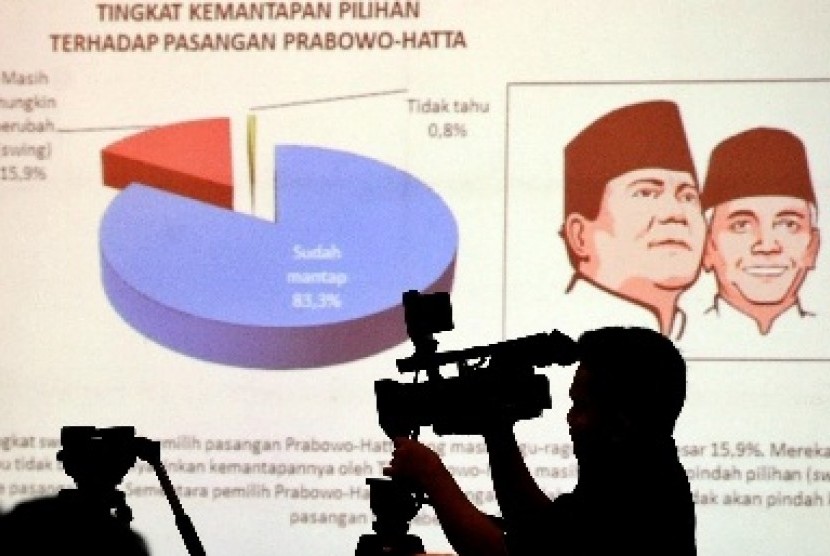REPUBLIKA.CO.ID, JAKARTA -- The electability of the Prabowo-Hatta ticket has reached 44.64 percent ahead of the election on July 9 while the Jokowi-HJ pair only at 42.79 percent, according to Puskaptis survey.
"The electability of the Prabowo-Hatta pair is 1.67 percent higher than that of the Jokowi-JK pair. Based on the data, the Prabowo-Hatta pair is entering a positive trend while the Jokowi-JK pair's trend is stagnant or even negative at 1.75 percent lower, the director of Puskaptis (Center of Development Policy and Strategy Study), Husin Yazid, said here on Sunday.
He said the electability of the Prabowo-Hatta ticket kept increasing while that of Jokowi-JK tended to decline or to be stagnant.
Based on the result of the Puskaptis survey from June 2 to 6, the Prabowo-Hatta ticket won in Java, Sumatra, Bali and East Nusa Tenggara while the Jokowi-JK pair in Sulawesi, Kalimantan, Papua and Maluku.
The Prabowo-Hatta pair also won in Banten, Central Java and East Java while the Jokowi-JK pair in Jakarta, West Java and Yogyakarta.
"We know most voters are in Java where the electability of the Prabowo-Hatta pair had increased by 5.6 percent or recorded a positive trend while that of the Jokowi-JK ticket down by 2.75 percent. The Prabowo team had to be careful with regard to voters in West Java," he said.
Husin said among reasons people preferred Prabowo were that he was a firm, authoritative, courageous, hard working, experienced figure in addition that a military figure was still needed to advance Indonesia.
Jokowi's supporters meanwhile said they preferred Jokowi because he was humble, wise, reaching out, has made achievements and clear vision and mission and did not like a military figure.
"It is undeniable personnel factors will affect people's choice," he said.
The survey was done based on quantitative and qualitative data collected from the public using survey instruments.
Respondents are national citizens in 33 provinces, 115 districts/cities who eligible to vote chosen proportionately at a provincial level.
The survey is done randomly involving 2,400 respondents with a sampling error of +1.8 percent at a reliability rate of 95 percent.
Samples were taken based on a multistage random sampling and chosen respondents were interviewed face to face by experienced interviewers.
An interviewer was responsible for 10 respondents in one village. Quality control on the survey results was done randomly on 20 percent of the total samples by supervisors through spot checks, Husni said.


